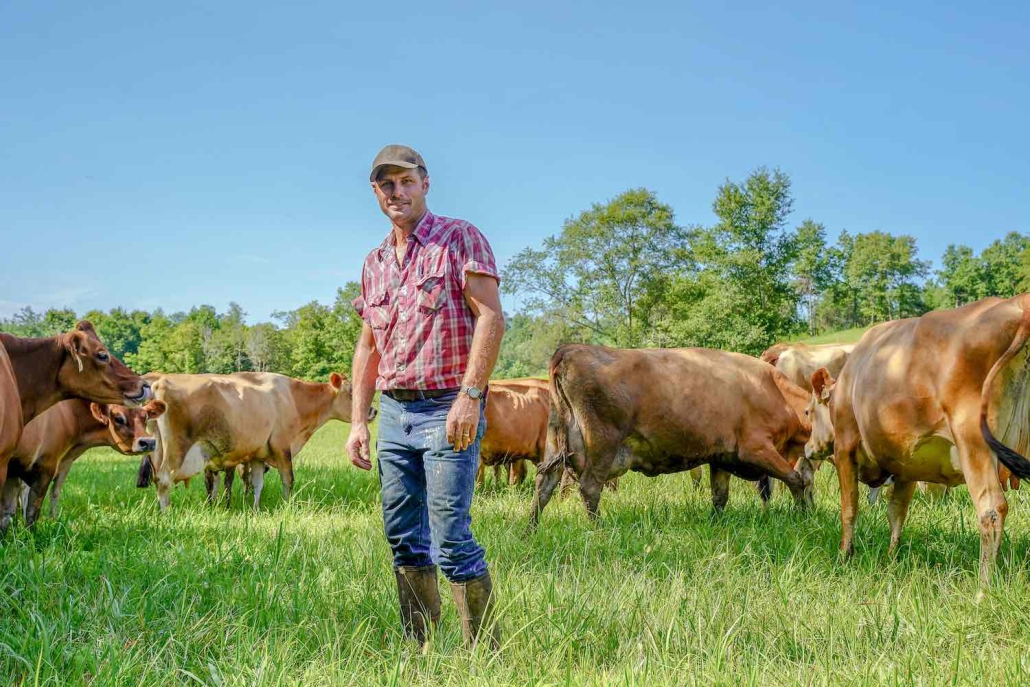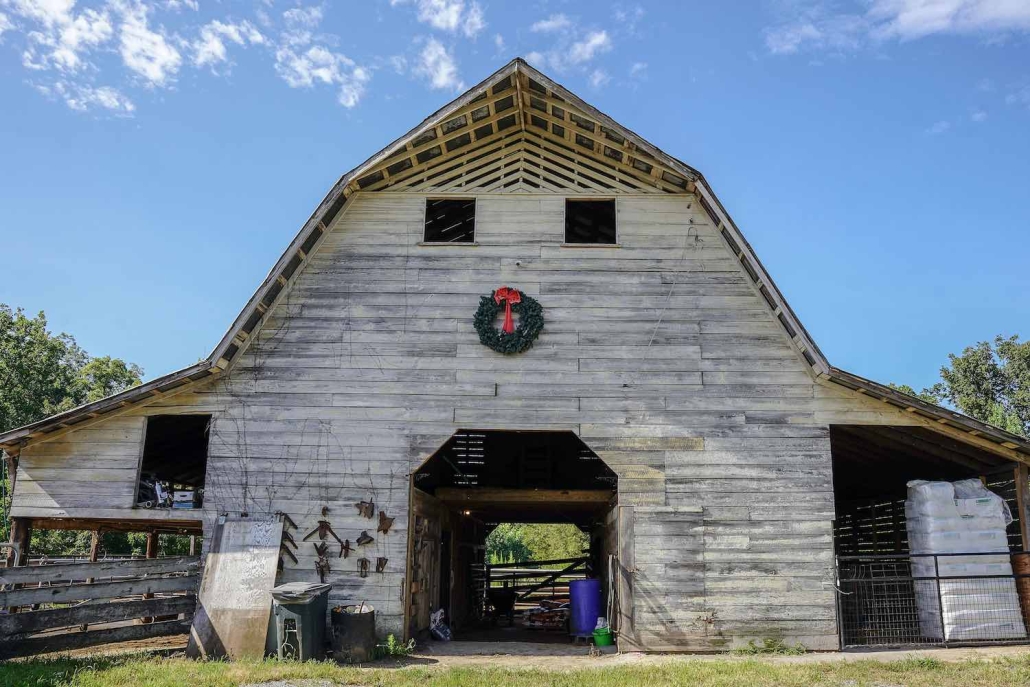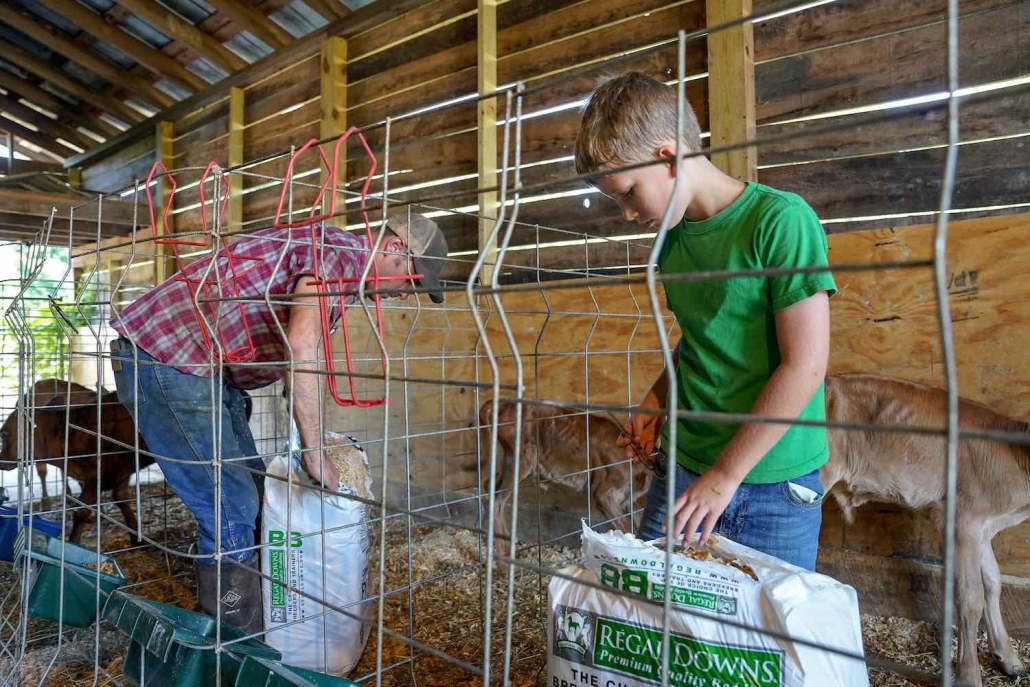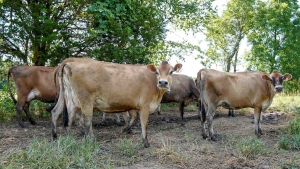Presented by Ingles Markets
THE ROAD TO REBUILDING
How a local dairy farm became a lifeline for neighbors and friends in the wake of Hurricane Helene
***
PHOTOS BY LEANNA ECHEVERRI
***
Not Preston Green and Stuart Beam, the owners of Big Bottom Milk Company in Rutherford County.
While Beam was making preparations for the storm, Green had to round up nearly 70 Jersey cows from a pasture on his farm and lead them to a barn for the morning milking. Green sloshed through eight inches of water that had pooled on the fields, feeling it overflow into his boots, and then led his cows one-by one across two deep creeks that had formed in the pastures overnight.
“We got to the barn and the cows were, for the most part, rock steady,” Green says. “But we could hear the trees falling around us. It was kinda eerie.”

Preston Green of Big Bottom Milk Co.
Big Bottom Milk Company, a dairy farm and creamery that supplies milk to about 100 regional retail locations, was a relatively new operation when the hurricane hit. Green had met Beam just a few years earlier when their own personal cows had broken out of their pens and got mixed up.
Discovering a shared love for farming, Green and Beam decided to revive a dairy operation on the 300-acre farm that had been in Beam’s family for generations—“it was a ‘land-grant farm’ from the King of England,” says Green. They bought a herd of dairy cows from Mills River Creamery as that business was shuttering. They also bought its creamery equipment, and essentially picked up where the previous owners left off.
”The cows were milked by [Mills River Creamery] in the morning and then by us that night,” says Green, who was born and raised on a dairy farm in Wisconsin before moving with his family to Western North Carolina.
When the storm hit, Green and Beam suffered in many of the same ways as thousands of others in our region. Their homes, yards and driveways were hit by fallen trees; they lost power and their kids’ schools were canceled.
But the unique thing about being a dairy farmer is that the work never stops. Come hell or high water, the cows have to be milked and the milk has to be shipped out. There is no pushing “pause” on the assembly line or hanging a “closed” sign on the front door.
In the weeks and months after Helene, Green and Beam scrambled to prop up their young business, facing major disruptions to the distribution network they had set up to get their milk to customers. But at the same time, the duo also found themselves at the center of grassroots aid operations, playing a key role in getting water, food, blankets and clothes—in addition to vital farming equipment—to friends and neighbors in the rural areas around them.

A barn at Big Bottom Milk Co.
On the morning of the storm, back in the milking barn, Green quickly discovered that the farm had lost power. He flipped on the generators and sighed with relief when the milking equipment kicked on. The Big Bottom creamery just up the road would also get a lifeline from generators, allowing the milk to be pasteurized and then bottled.
The bigger and more pressing problem was getting the milk out to customers. All across Western North Carolina, the roads were washed out, flooded or blocked by fallen trees. Their primary distributor, which they use to deliver their milk to local stores, had been severely damaged and one of their biggest customers, a milk processor in the region that typically bought up to 80% of Big Bottom’s supply, wasn’t operating.
“We weren’t just going to dump the milk,” Green says. So they started making deliveries themselves, using two trucks they had on the farm and recruiting staff and even family members to get the milk to any location they could reach. In some cases, they were able to get milk to regular customers. “I personally drove to the Ingles store in Forest City and dropped off gallons there,” Green says. “The store manager told us to keep bringing him whatever we could.”
The milk deliveries were a godsend, but there was a more pressing need for water. City water had been shut off, and nothing was coming through the faucets of the region’s homes and farms. People needed drinking water for themselves and their animals, not to mention water for cooking, flushing toilets and bathing.
Big Bottom’s farm, by a stroke of good fortune, was still getting water. So they expanded their focus to delivering water and quickly got a permit to use their bottling equipment for that. After bottling milk, they’d shift the supply lines to water and fill gallon after gallon with potable water. They’d delivered pallets to aid operations, rescue workers and food distribution sites.
“People needed not just bottles, but gallons and even totes,” Green says, estimating they ended up distributing around 30,000 gallons of water.
Meanwhile, a grassroots relief effort started to gain momentum around the country, with donors leaning on social media and word of mouth to find out how to help. And Big Bottom Milk Company teamed up with Overmountain Vineyards in nearby Tryon to become a destination site for donations and a coordination hub for relief efforts.
“We had trucks coming and leaving all day—trucks from Pennsyl – vania and Michigan,” Green says. “People just sent what they thought we’d need.”
The two partners then started to appeal for specific items for other regional farmers who needed equipment. Everything from hay to fence posts, farmers needed tools and supplies to repair their operations and get back on their feet.
Big Bottom also received cash donations, which they used to purchase large quantities of butter and flour for local fire departments that were making biscuits—thousands of biscuits—for local residents who didn’t have food.
All the while, the milking didn’t stop. The team at Big Bottom continued to milk the cows twice a day—morning and evening—and kept finding ways to deliver the milk.

Preston Green and his son at Big Bottom Milk.
The milk processing plant that had formerly purchased the majority of Big Bottom’s milk was no longer buying. So Green and Beam had to work quickly to expand their network of retail locations; the milk had to have a place to go. They delivered to roughly 20 stores for Ingles, their largest customer, as well as Earth Fare and a smattering of smaller locations, like the Hendersonville Food Co-op in Henderson County and All Good Things Bakery in Tryon. With that expansion, they also had to line up new supplies of jugs, caps and labels. “It’s hard to grow that fast; getting the milk out was challenging,” Green says. “But we did it. Our team was and is amazing and they jumped in.”
These days, Big Bottom Milk is working to stabilize its business operations. “We’re normalizing in that growth mode,” Green says. They produce a lineup of milk products, from regular gallons to varieties flavored with chocolate, peach and strawberry milk, and they have a quickly growing fan base. “It’s amazing to see people rally around the business and the brand,” Green says. “It’s mind-blowing when you’re stocking a shelf in Asheville and someone says, ‘Oh, that’s the good milk.’”
But even in good times, the job of being a dairy farmer is hard— relentless work that is often both physically and emotionally demanding. “You can’t do this kind of work for the money; it’s a lifestyle,” Green says. “You have to have the mind-set that you’re building for a future generation.”
The “Road to Rebuilding” series is presented in partnership with Ingles Markets, celebrating and honoring businesses in Western North Carolina that are rebuilding after Hurricane Helene.
Save
Save
Save
Save
Save
Save
Save
Save
Save
Save

Dairy cows at Big Bottom Milk Co.
THE WEEKLY REVEL
Sign up for your free handpicked guide to enjoying life around Asheville.
Available weekly from May to October.





